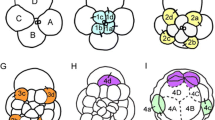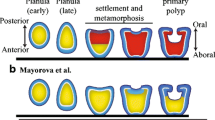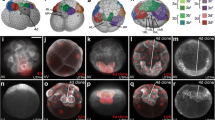Abstract
The sea anemone Nematostella vectensis has recently been established as a new model system for the understanding of the evolution of developmental processes. In particular, the evolutionary origin of gastrulation and its molecular regulation are the subject of intense investigation. However, while molecular data are rapidly accumulating, no detailed morphological data exist describing the process of gastrulation. Here, we carried out an ultrastructural study of different stages of gastrulation in Nematostella using transmission electron microscope and scanning electron microscopy techniques. We show that presumptive endodermal cells undergo a change in cell shape, reminiscent of the bottle cells known from vertebrates and several invertebrates. Presumptive endodermal cells organize into a field, the pre-endodermal plate, which undergoes invagination. In parallel, the endodermal cells decrease their apical cell contacts but remain loosely attached to each other. Hence, during early gastrulation they display an incomplete epithelial–mesenchymal transition (EMT). At a late stage of gastrulation, the cells eventually detach and fill the interior of the blastocoel as mesenchymal cells. This shows that gastrulation in Nematostella occurs by a combination of invagination and late immigration involving EMT. The comparison with molecular expression studies suggests that cells expressing snailA undergo EMT and become endodermal, whereas forkhead/brachyury expressing cells at the ectodermal margin of the blastopore retain their epithelial integrity throughout gastrulation.








Similar content being viewed by others
References
Arendt D (2004) Comparative aspects of gastrulation. In: Stern C (ed) Gastrulation: from cells to embryo. Cold Spring Harbor Laboratory Press, Cold Spring Harbor
Ball EE, Hayward DC, Reece-Hoyes JS, Hislop NR, Samuel G, Saint R, Harrison PL, Miller DJ (2002) Coral development: from classical embryology to molecular control. Int J Dev Biol 46:671–678
Barrallo-Gimeno A, Nieto MA (2005) The Snail genes as inducers of cell movement and survival: implications in development and cancer. Development 132:3151–3161
Benesch R (1969) Zur Ontogenie und Morphologie von Artemia salina. Zool Jb Anat 86:307–458
Byrum CA (2001) An analysis of hydrozoan gastrulation by unipolar ingression. Dev Biol 240:627–640
Byrum CA, Martindale MQ (2004) Gastrulation in the Cnidaria and Ctenophora. In: Stern C (ed) Gastrulation: from cells to embryo. Cold Spring Harbor Laboratory Press, Cold Spring Harbor
Cano A, Perez-Moreno MA, Rodrigo I, Locascio A, Blanco MJ, del Barrio MG, Portillo F, Nieto MA (2000) The transcription factor Snail controls epithelial–mesenchymal transitions by repressing E-cadherin expression. Nat Cell Biol 2:76–83
Carlsson P, Mahlapuu M (2002) Forkhead transcription factors: key players in development and metabolism. Dev Biol 250:1–23
Collins AG (2002) Evaluating multiple alternative hypotheses for the origin of Bilateria: an analysis of 18S rRNA molecular evidence. Proc Natl Acad Sci U S A 95:15258–15463
Darling JA, Reitzel AR, Burton PM, Mazza ME, Ryan JF, Sullivan JC, Finnerty JR (2005) Rising starlet: the starlet sea anemone, Nematostella vectensis. BioEssays 2:211–221
Davidson LA, Oster GF, Keller RE, Koehl MAR (1999) Measurements of mechanical properties of the blastula wall reveal which hypothesized mechanisms of primary invagination are physically plausible in the sea urchin Strongylocentrotus purpuratus. Dev Biol 209:221–238
del Barrio MG, Nieto MA (2002) Overexpression of Snail family members highlights their ability to promote chick neural crest formation. Development 129:1583–1593
Finnerty JR, Pank K, Burton P, Paulson D, Martindale MQ (2004) Origins of bilateral symmetry: Hox and dpp expression in a sea anemone. Science 304:1335–1337
Fritzenwanker JH, Technau U (2002) Induction of gametogenesis in the basal cnidarian Nematostella vectensis (Anthozoa). Dev Genes Evol 212:99–103
Fritzenwanker JH, Saina M, Technau U (2004) Analysis of forkhead and snail expression reveals epithelial–mesenchymal transitions during embryonic and larval development of Nematostella vectensis. Dev Biol 275:389–402
Gemmill JF (1920) The development of the sea anemones Metridium dianthus (Ellis) and Adamsia palliata (Bohad). Philos Trans R Soc Lond B 209:357–367
Gross JM, McClay DR (2001) The role of Brachyury (T) during gastrulation movements in the sea urchin Lytechinus variegates. Dev Biol 239:132–147
Haeckel E (1874) The Gastraea—theory, the phylogenetic classification of the animal kingdom and the homology of germ-lamellae. Q J Microsc Sci 14:142–165
Hand C, Uhlinger KR (1992) The culture, sexual and asexual reproduction, and growth of the sea anemone Nematostella vectensis. Biol Bull 182:169–176
Hayward DC, Miller DJ, Ball EE (2004) Snail expression during embryonic development of the coral Acropora: blurring the diploblast/triploblast divide? Dev Genes Evol 214:257–260
Hyde I (1894) Entwicklungsgeschichte einiger Scyphomedusen. Zeitschrift Wiss Zool 58:553–563
Ikenouchi J, Matsuda M, Furuse M, Tsukita S (2003) Regulation of tight junctions during the epithelium–mesenchyme transition: direct repression of the gene expression of claudins/occludin by Snail. J Cell Sci 116:1959–1967
Katow H, Sollursh M (1980) Ultrustructure of primary mesenchyme cell ingression in the sea urchin Lytechinus pictus. J Exp Zoolog 213:231–246
Keller R, Davidson L, Shook D (2003) How we are shaped: the biomechanics of gastrulation. Differentiation 71:171–205
Kim J, Kim W, Cunningham CW (1999) A new perspective on lower metazoan relationships from 18S rDNA sequences. Mol Biol Evol 16:423–427
Kimberly EL, Hardin J (1998) Bottle cells are required for the initiation of primary invagination in the sea urchin embryo. Dev Biol 204:235–250
Kraus YA, Cherdantsev VG (1999) Variability and equifinality in the early morphogenesis of the marine hydroid, Dynamena pumila. Russ J Dev Biol 30:118–129
Kusserow A, Pang K, Sturm C, Hrouda M, Lentfer J, Schmidt HA, Technau U, von Haeseler A, Hobmayer B, Martindale MQ, Holstein TW (2005) Unexpected complexity of the Wnt gene family in a sea anemone. Nature 433:156–160
Leptin M, Roth S (1994) Autonomy and non-autonomy in Drosophila mesoderm determination and morphogenesis. Development 120:853–859
Locascio A, Nieto MA (2001) Cell movements during vertebrate development: integrated tissue behavior versus individual cell migration. Curr Opin Genet Dev 11:464–469
Martin VJ, Thomas M (1977) A fine structural study of embryonic and larval development in the gimnoblastic hydroid Pennaria tiarella. Biol Bull 153:198–218
Martin VJ, Littefield, JCL, Archer WE, Bode HR (1997) Embryogenesis in Hydra. Biol Bull 192:345–363
Martindale MQ, Pang K, Finnerty JR (2004) Investigating the origins of triploblasty: ‘mesodermal’ gene expression in a diploblastic animal, the sea anemone Nematostella vectensis (phylum Cnidaria; class, Anthozoa). Development 131:2463–2474
Medina M, Collins AG, Silberman JD, Sogin ML (2001) Evaluating hypotheses of basal animal phylogeny using complete sequences of large and small subunit rRNA. Proc Nat Acad Sci U S A 98:9707–9712
Metchnikoff E (1886) Embryologische Studien an Medusen. Ein Beitrag zur Genealogie der Primitiv-Organe. Alfred Holder, Vienna
Miyoshi A, Kitajima Y, Kido S, Shimonishi T, Matsuyama S, Kitahara K, Miyazaki K (2005) Snail accelerates cancer invasion by upregulating MMP expression and is associated with poor prognosis of hepatocellular carcinoma. Br J Cancer 92:252–258
Newby WW (1940) The embryology of Echiuroid worm Urechis caupo. Mem Am Philos Soc 16:1–219
Nieto MA (2002) The Snail superfamily of zinc-finger transcription factors. Nat Rev Mol Cell Biol 3:155–166
Oda H, Tsukita S (2000) Real-time imaging of cell–cell adherens junctions reveals that Drosophila mesoderm invagination begins with two phases of apical constriction of cells. J Cell Sci 114:493–501
Prindull G, Zipori D (2004) Environmental guidance of normal and tumor cell plasticity: epithelial mesenchymal transitions as a paradigm. Blood 103:2892–2899
Rattenbeury J (1954) The embryology of Phoronis viridis. J Morphol 95:289–334
Rodimov A (2000) A history of embryonic development of Bougainvillia superciliaris. News of St. Petersburg University 2(11):122–126
Savagner P (2001) Leaving the neighborhood: molecular mechanisms involved during epithelial–mesenchymal transition. BioEssays 23(10):912–923
Schaefer W (1985) Fortpflanzung und Entwicklung von Anemonia sulcata (Anthozoa, Actiniaria). II. Fruehentwicklung, Blastula und Gastrula. Helgolaender Meeresunters 39:341–356
Scholz CB, Technau U (2003) The ancestral role of Brachyury: expression of Nembra1 in the basal cnidarian Nematostella vectensis (Anthozoa). Dev Genes Evol 212:563–570
Shook D, Keller R (2003) Mechanisms, mechanics and function of epithelial–mesenchymal transitions in early development. Mech Dev 120:1351–1383
Showell C, Binder O, Conlon FL (2004) T-box genes in early embryogenesis. Dev Dyn 229:201–218
Tardent P (1978) Coelenterata. Cnidaria. VEB Gustav Fischer, Jena
Technau U, Scholz CB (2003) Origin and evolution of endoderm and mesoderm. Int J Dev Biol 47:531–539
Weigel D, Jurgens G, Kuttner F, Seiffert E, Jackle H (1989) The homeotic gene fork head encodes a nuclear protein and is expressed in the terminal regions of the Drosophila embryo. Cell 57:645–658
Wikramanayake AH, Hong M, Lee PN, Pang K, Byrum CA, Bince JM, Xu R, Martindale MQ (2003) An ancient role for nuclear beta-catenin in the evolution of axial polarity and germ layer segregation. Nature 426:446–450
Wulfert J (1902) Die Embryonalyentwicklung von Gonothyraea loveni. Allg Zeitschrift Wiss Zool 71:296–325
Acknowledgements
We thank Jens Fritzenwanker and Tom Clarke for critically reading the manuscript. We also thank the members of the Laboratory of Electron Microscopy of Moscow State University (G.N. Davidovich, A.G. Bogdanov, N. Zvonkova, M. Leontieva, A. Lazarev, N.Y. Agalakova) for support and assistance. This work was supported by the DFG and the core budget of the Sars Centre.
Author information
Authors and Affiliations
Corresponding author
Additional information
Communicated by M.Q. Martindale
Rights and permissions
About this article
Cite this article
Kraus, Y., Technau, U. Gastrulation in the sea anemone Nematostella vectensis occurs by invagination and immigration: an ultrastructural study. Dev Genes Evol 216, 119–132 (2006). https://doi.org/10.1007/s00427-005-0038-3
Received:
Accepted:
Published:
Issue Date:
DOI: https://doi.org/10.1007/s00427-005-0038-3




